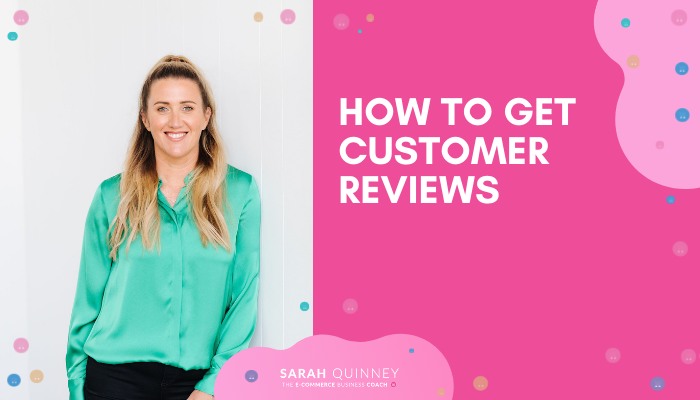
How to Get Customer Reviews
Customers often factor in many things when making the decision to purchase from your business. Fortunately, due to the internet being so efficient and fast-paced, making a purchase online is usually done quickly, without the need to speak to any salesperson.
So, what do customers look for when they are deciding to buy from you? Recommendations, testimonials, and reviews. Therefore, your existing and loyal customers are incredibly valuable representatives for your business. But what can we do to get reviews? Truthfully, a lot! Great customer service is where we start, but beyond that, there are many different ways to encourage customer feedback.
The importance of customer reviews
Consumers are beginning to trust brands less. According to Hubspot, 55% of customers trust businesses less than in years past. Customers are wary of misinformation, the onslaught of branded content, and the collection of personal data in which many corporations and sellers participate. As a result, businesses need to tread carefully in attempting to gain trust of their customers.
For E-commerce sellers, this means that good reviews are going to continue to become more and more important. This is especially so when it comes to getting reviews from people they trust, like friends and family This suggests that positive reviews, opinions, and experiences of existing customers provide value and trust for a business. They can drive sales and even convince a potential customer to take the plunge and buy from you.
How to get reviews
Ask for them
Most customers don’t leave reviews unless they’re asked. The best way to increase your chance of gaining reviews is to simply ask for them! This can be done through post-purchase emails, SMS messages, social media, or even in-package inserts.
If sending a review request via email or SMS message, it is important to recognise the right moment to ask inquire into how the buyer’s journey has been. Here are some post-sale ideas for sending review requests:
- Timed to arrive in their email after product delivery
- In standard, pre-set intervals after ordering (i.e. 7 days)
- When the customer re-purchases
- When the customer returns to your website
- If the customer adds new items to their cart
- If they tag you on social media (you could ask for a review via DM)
Depending on the type of product you offer, you will want to inquire about reviews at varying times. If your products take a while to use and test out, you don’t want to time your review request with delivery — they won’t have used the item yet!
Remember, customers are often busy, so following up on your request for a review is ok as it improves the chance of the customer taking the time immediately to get it done.
Provide prompts
It can be useful to provide prompts and questions when asking for reviews. This can give customers ideas about things that they can mention in their response. It’s important to remember that you can’t tell them what to say.
- How did you feel about xyz?
- Did xyz live up to your expectations?
- Did xyz arrive as you expected?
- What did you think of our packaging?
- How was your shopping experience?
- How can we improve?
Start with an open-ended question that establishes a conversation rather than asking bluntly for a review. Additionally, You can make it easier for your customers by sending a simple email survey or an SMS message asking them to write a review. Make sure your texts and surveys are interactive and can be accessed on different-sized devices to encourage responses.
Offer something
An easy way to encourage reviews is to offer something in return. Everybody loves a good incentive, and offering something like a discount or coupon code can be a great method!
Discounts, credits, promo codes, or even gifted products are some of the many ways in which you can incentivise the review process. Customers love when businesses give back, so you might as well test out a method or two!
Remember to include relevant incentive information in your review request email or message.
Utilize social media
Reviews are great for driving future sales, but they’re also useful in telling us how we can improve. Social media is a great place to ask for feedback, and in-app tools can be a great place to start! Try using Instagram’s story features (like polls and question boxes) to ask for feedback. You can repost what you wish, and use any helpful critiques to improve your business processes.
Why you should respond to reviews
It is important to respond to both positive and negative reviews. This shows that there are real humans behind the store, and it’s a great way to increase customers’ perception of your brand personality.
When a customer leaves a review, thank them! If it’s positive, tell them you’re happy that they’re happy. If it’s negative, do everything in your power to remedy the situation. In fact, responding to negative reviews is a valuable way to lessen their negative impact.
Work to remedy any negative experiences, whether it means sending replacement products, future sale codes, or anything else. If needed, encourage the customer to contact your business outside of the review forum so the matter can be handled privately.
When you respond to negative reviews and make an effort to fix mistakes, it shows future shoppers that you care about their experience.
While negative reviews are often inescapable, Harvard Business Review states that monitoring and responding to negative reviews can actually increase a business’s overall ratings. A business that demonstrates empathy and compassion for its customers is often seen as trustworthy and personal.
How to integrate reviews onto your website
In order for reviews to truly do their job, they need to be accessible and seen! Google Business and Facebook can be useful spots for reviews, E-Commerce sellers should be including reviews directly on product pages.
Rather than using a third-party platform, integrate a review plug-in or widget into your website. This will allow reviews to be showcased on product pages for ease, quick information, and, ultimately, an increase in sales.
Some WordPress and Shopify templates may come with review integrations. If yours doesn’t, here are some well-reviewed (see how reviews work?!) options.
For WordPress, two options include WP Review Pro and Customer Reviews for WooCommerce.
For Shopify, options include Stamped Product Reviews and Yotpo.
Providing a great overall experience is key to ensuring these strategies work for your business. Quality customer service and support is your profit maker. The most challenging part of the customer lifecycle begins post-sale when the customer is out in the world with your product, free to say what they want about your business. Do everything in your effort to provide the best service possible so that those opinions may be positive.

Ready to scale your online store?
The E-Commerce Women In Business Mastermind – your exclusive e-commerce coaching and e-commerce digital marketing mentorship for women looking to Grow and Scale your online store. Click here to learn more
Yours in success,
Sarah x
